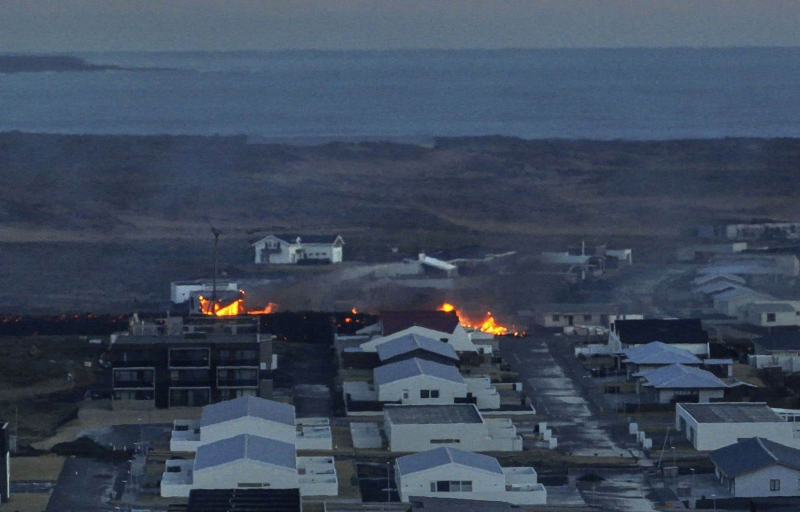
Halldór Kolbeins Agence France-Presse Mid-afternoon on Sunday, two houses in Grindavík were hit by hot lava and immediately caught fire, releasing large plumes of black smoke. A third house was also burned.
Jérémie Richard – Agence France-Presse to Reykjavik
January 14, 2024
- Europe
Lava from a volcano that erupted on Sunday near the fishing port of Grindavík, in southwest Iceland, set fire to three homes in the locality, whose residents had been evacuated a few hours earlier .
This is the fifth volcanic eruption in Iceland in almost three years, the previous one having taken place on the evening of December 18 in the same area. But lava hadn’t reached homes in 51 years.
The seismic activity accelerated sharply during the night and the few dozen residents resettled at the end of December in this small town, located about forty kilometers southwest of Reykjavik, were evacuated around 3 a.m. (local time).
Two cracks then opened, one around 8 a.m. some 400 meters from the town and the other at midday on the edge of the first homes, according to the Icelandic Meteorological Office (IMO), spewing large flows bright orange lava.
In the middle of the afternoon, two houses were hit by the burning lava and immediately caught fire, releasing large plumes of black smoke, according to images from surveillance cameras broadcast by television Icelandic public. A third house was also later burned.
“In a small town like this, we are all like family, we all know each other like family, so it’s a tragedy to see this,” reacted to AFP Sveinn Ari Gudjonsson, 55, a Grindavík resident evacuated in November.
“It’s unreal. It’s like watching a movie,” adds the man who works in the fishing industry.
“Black Day”
Speaking at a press conference, Icelandic Prime Minister Katrín Jakobsdóttir lamented “a dark day for Grindavík and for all of Iceland.”
“But the sun will rise again,” she promised. “Together we will face this trauma. »
Grindavík, which has 4,000 inhabitants, was evacuated on November 11 as a precaution after hundreds of earthquakes caused by the movement of magma under the earth's crust – a precursor to a volcanic eruption.
These earthquakes damaged the city, creating large cracks in the roads and in houses and public buildings.
“The last time lava reached homes was 51 years ago,” recalled President Guðni Jóhannesson, during a rare address on public television.
“We hope that things will calm down, that everyone will be able to return, but […] everything is possible. We must remain hopeful,” he added.
Shortly after the eruption of December 18, residents were allowed to return briefly to Grindavík, then permanently since December 23, before being urgently evacuated on the night of Saturday in Sunday.
Only a few dozen residents had returned to their homes.
Authorities on Saturday evening issued an order to evacuate the city by Monday due to seismic activity and its impact on existing crevasses in the city. So they had to speed up the pace during the night.
Disappearance
This decision also follows the disappearance on Wednesday of a 51-year-old Icelandic man who was working in a private garden when the ground suddenly slipped beneath his feet.
The man, who was not found, fell more than thirty meters into a crevasse.
The authorities are closely monitoring the Svartsengi geothermal power station, located in the same area and which provides electricity and water to around 30,000 inhabitants of the region, and whose installations are protected by a wall.< /p>
Until the March 2021 eruption, the Reykjanes Peninsula, south of the capital, Reykjavik, had been spared from eruptions for eight centuries.
There have been four others since, in August 2022, in July 2023, on December 18, 2023 and this Sunday morning, a sign, for volcanologists, of a resumption of volcanic activity in the region.
Four days after the December 18 eruption, authorities declared that volcanic activity had stopped, but could not say whether the eruption was over, due to possible lava flows in basement.
Thirty-three volcanic systems are considered active in this land of fire and ice, the most volcanic region in Europe.

